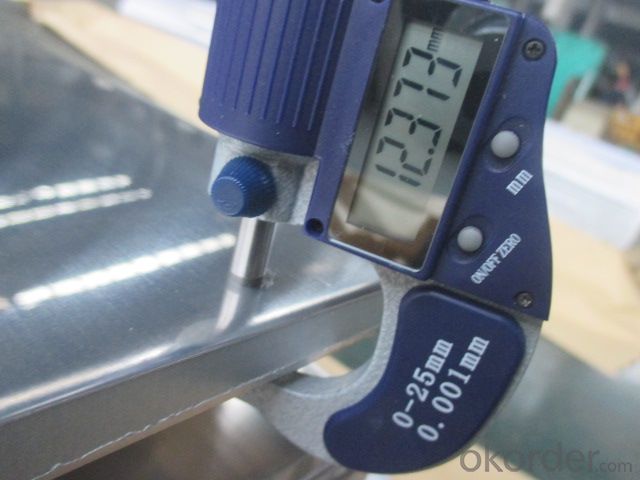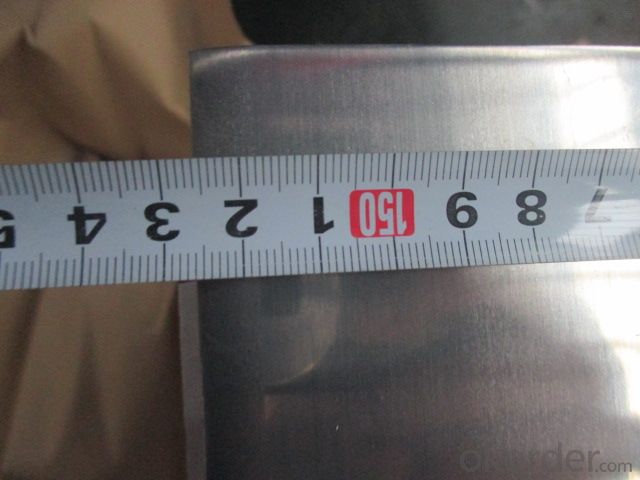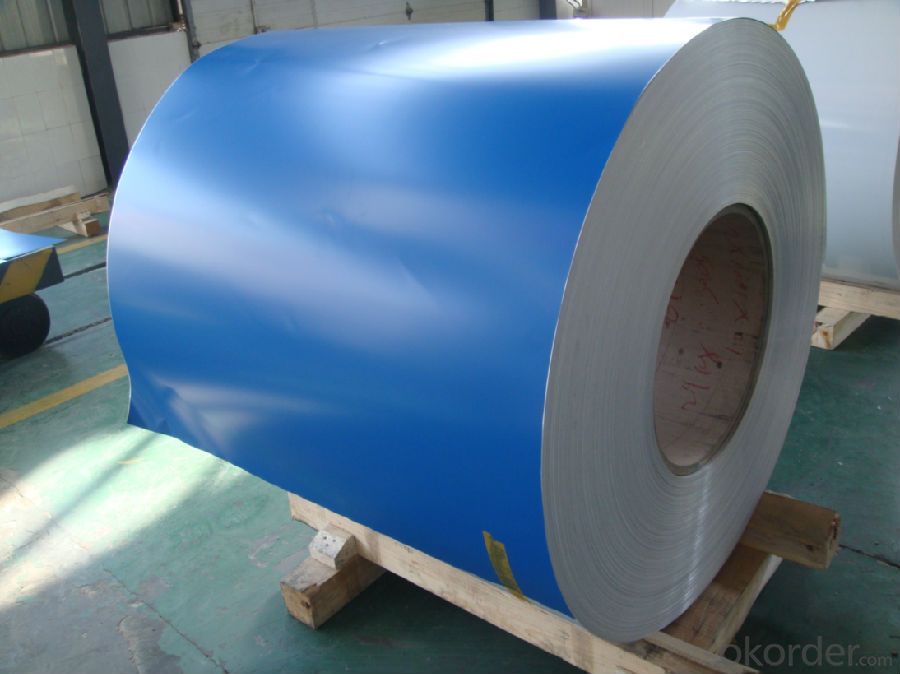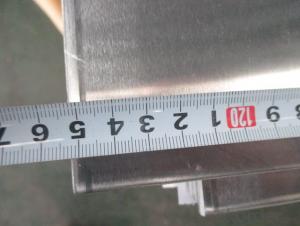Aluminium Sheet With Best Disount Price Warehouse
- Loading Port:
- Shanghai
- Payment Terms:
- TT OR LC
- Min Order Qty:
- 4 m.t
- Supply Capability:
- 200 m.t/month
OKorder Service Pledge
OKorder Financial Service
You Might Also Like
Item specifice
1.Structure of Product Description
Cold rolled aluminum sheet is widely used in the field of construction field and decoration field, etc.
There are many different grades, such as: 1000 series, 2000 series, 3000 series, 5052,5754,7075,3105,6063,8011, etc.
The temper is include H14, H22, H24, H44,H112,H114,etc.
2. Main features of the product
a.Competitive price
b.Frist-Class Service.
c. Shortest service.
3. Image.



4. Product detailed sizes:
1000mm*2000mm, 1220mm*2440mm, 1250mm*2500mm,1500mm*3000mm, etc.
5. FAQ:
What is the quality standard?
---Usually our standard is GB3880-2006 or others.
What is the width range?
---It is from 1000mm to 2500mm, etc.
---Normally it is around 9000 tons totally.
Where is your client from?
---Normally it is from Japan,ENGL,
AND, FIJI, SRI LANKA, ETCENGLISH, SINGAPORE, ETC.
What is your mainly products?
---Normally they are aluminum sheet, checkered sheet, mirror finish aluminium sheet, aluminum casting coil, etc.
- Q:Curtain wall aluminum plate reinforcement spacing between the number of appropriate, the country has no standard?
- As to the stiffener of the aluminum veneer, what are the following points?:1, aluminum reinforcement spacing is generally around 600mm, in order to ensure the aluminum plate in the positive and negative pressure conditions within the scope of deformation. When aluminum plate is welded, there is internal stress due to welding deformation (this internal stress can not be completely eliminated for a long time), and the rigidity of reinforcing bar should also be increased.2. The sectional dimension and spacing of stiffeners shall be determined according to the calculated wind pressure of the aluminum plate. But it is worth noting that the reinforcement calculation of single aluminum plate strengthening is different from the glass curtain wall, first, its strength is certainly no problem (still not seen the wind blowing broken plate, there is no joke) deflection possibility, bend off and windy weather also very few people to pay attention to the single aluminum plate plate surface after deformation the scenery. Therefore, the calculation of deflection of stiffeners are considered under the condition of wind strength and deflection when the winds of aluminum can cause permanent plastic deformation.In fact, aluminum veneer manufacturers generally use the single aluminum plate edge folding groove made of aluminum and 20*40*20, installed in the distance about 600mm. Also useful for profile (grooved aluminum) stiffenersThe spacing between stiffeners is very important to the cost of production. Generally speaking, the spacing of stiffeners will be changed from 600 to 350, and the cost will be increased by 8~15 yuan / square meter
- Q:Are aluminum sheets suitable for elevator interiors?
- Yes, aluminum sheets are suitable for elevator interiors. Aluminum is a durable and lightweight material that is resistant to corrosion, making it ideal for use in elevator interiors. It can be easily customized and offers a sleek and modern aesthetic. Additionally, aluminum is easy to clean and maintain, making it a practical choice for elevator interiors.
- Q:How is aluminum obtained from its ore?
- Aluminum is obtained from its ore through a process called the Bayer process. First, the ore, called bauxite, is crushed and mixed with a solution of sodium hydroxide. This mixture is then heated and pressurized in a digester, causing the aluminum oxide to dissolve and form sodium aluminate. After the impurities are removed, the sodium aluminate solution is cooled and treated with carbon dioxide, which converts it into aluminum hydroxide. Finally, the aluminum hydroxide is heated and transformed into pure aluminum metal through electrolysis.
- Q:What are the different types of alloys used for aluminum sheets?
- There are various types of alloys used for aluminum sheets, including 1xxx, 3xxx, 5xxx, and 6xxx series. Each alloy has unique properties and characteristics, making them suitable for different applications. The 1xxx series alloys are pure aluminum, while the 3xxx series alloys contain manganese and exhibit good formability. The 5xxx series alloys have magnesium as the primary alloying element and offer excellent corrosion resistance. Lastly, the 6xxx series alloys are known for their combination of strength, formability, and weldability, with magnesium and silicon as their main alloying elements.
- Q:Are aluminum sheets suitable for marine hulls?
- Indeed, marine hulls can indeed be made using aluminum sheets. The utilization of aluminum in boat construction is widespread due to its numerous advantageous properties. The lightweight nature of aluminum enables enhanced fuel efficiency and increased speed. Furthermore, its exceptional resistance to corrosion renders it well-suited for prolonged exposure to saltwater. Moreover, aluminum possesses remarkable strength and durability, thereby ensuring the integrity of the hull's structure. Additionally, aluminum can be easily manipulated into intricate shapes, allowing for the creation of innovative hull designs. In summary, aluminum sheets represent a dependable and efficient option for marine hulls, delivering a robust and corrosion-resistant framework that enhances the boat's performance and lifespan.
- Q:Can 101 aluminum sheets be used in aerospace applications?
- Yes, 101 aluminum sheets can be used in aerospace applications. 101 aluminum is a commonly used alloy in the aerospace industry due to its excellent strength-to-weight ratio, high corrosion resistance, and good formability. It is often used for structural components, such as aircraft skins, wings, and fuselage panels. Additionally, 101 aluminum sheets can be easily machined and welded, making them ideal for aerospace applications where precision and durability are crucial.
- Q:Can aluminum sheets be embossed or engraved?
- Yes, aluminum sheets can be embossed or engraved. Embossing involves creating a raised design or pattern on the surface of the aluminum sheet, while engraving involves cutting or etching a design into the surface. Both techniques can be used to add decorative or functional elements to aluminum sheets. Embossed or engraved aluminum sheets are commonly used in various industries including automotive, aerospace, signage, and architectural applications. The process of embossing or engraving aluminum sheets typically involves using specialized machinery or tools to create the desired design.
- Q:How does the thickness tolerance of aluminum sheet affect its usability?
- The usability of aluminum sheet is greatly influenced by its thickness tolerance, which refers to the acceptable deviation from the specified thickness. This tolerance is typically expressed as a range or a plus/minus value. Having a tighter thickness tolerance guarantees that the aluminum sheet consistently meets the desired specifications. This is crucial in industries such as aerospace, automotive, and construction, where precise dimensions are necessary. Even a slight deviation in thickness can have a negative impact on the performance and functionality of the product. For example, in aircraft manufacturing, the thickness tolerance of aluminum sheets used for structural components is of utmost importance. A thin sheet could compromise the structural integrity, while a thicker sheet could add excess weight, affecting fuel efficiency. Similarly, in the automotive industry, precise thickness tolerance is vital to ensure compatibility and fitment of various components. On the other hand, a looser thickness tolerance may be acceptable in applications where precise dimensions are not as critical. For instance, in general fabrication, signage, or decorative purposes, a wider thickness tolerance may not significantly affect the usability or appearance of the aluminum sheet. Furthermore, manufacturing aluminum sheets with tighter thickness tolerances generally incurs higher costs due to increased precision and quality control measures. Therefore, the desired level of tolerance should be carefully balanced with the intended use and cost considerations. To conclude, the usability of aluminum sheet is directly influenced by its thickness tolerance, particularly in industries that require precise dimensions. Selecting the appropriate tolerance level is essential to ensure that the sheet meets the necessary specifications and maintains the desired performance and functionality of the final product.
- Q:What is the density of the 1100 aluminum plate?
- 1100 aluminum density is fand 2.7g/cm.1100 for industrial pure aluminum, aluminum content (mass fraction) of 99%, can not be enhanced by heat treatment. With high corrosion resistance, electrical conductivity and thermal conductivity, and its small density, good plasticity, through pressure processing can produce all kinds of aluminum, but the strength is low.
- Q:Can aluminum sheets be an alternative to glass in certain applications?
- Yes, aluminum sheets can be an alternative to glass in certain applications. Aluminum is lightweight, durable, and has excellent corrosion resistance, making it suitable for outdoor and industrial applications where glass may be prone to breakage or damage. Additionally, aluminum sheets can provide better insulation and soundproofing properties compared to glass. However, it is important to consider specific requirements and limitations of each application before choosing aluminum sheets as an alternative to glass.
1. Manufacturer Overview |
|
|---|---|
| Location | |
| Year Established | |
| Annual Output Value | |
| Main Markets | |
| Company Certifications | |
2. Manufacturer Certificates |
|
|---|---|
| a) Certification Name | |
| Range | |
| Reference | |
| Validity Period | |
3. Manufacturer Capability |
|
|---|---|
| a)Trade Capacity | |
| Nearest Port | |
| Export Percentage | |
| No.of Employees in Trade Department | |
| Language Spoken: | |
| b)Factory Information | |
| Factory Size: | |
| No. of Production Lines | |
| Contract Manufacturing | |
| Product Price Range | |
Send your message to us
Aluminium Sheet With Best Disount Price Warehouse
- Loading Port:
- Shanghai
- Payment Terms:
- TT OR LC
- Min Order Qty:
- 4 m.t
- Supply Capability:
- 200 m.t/month
OKorder Service Pledge
OKorder Financial Service
Similar products
New products
Hot products
Related keywords




























